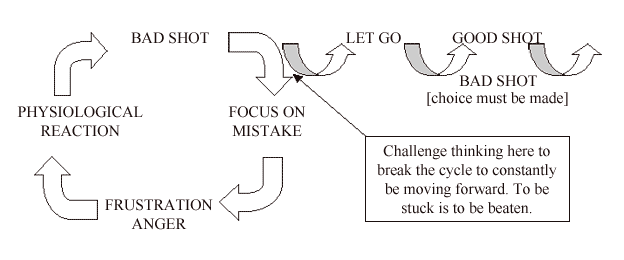| |
The Black Hole of Frustration
Todd Monger, MA, LPC, NCC
A black hole is space phenomenon in which the gravitational
pull of a collapsing galaxy is so strong that even light cannot
escape. It begins by a large star exploding, known as a supernova.
The remaining materials then collapse to form a neutron star
which continues to increase in pressure until it implodes
creating a black hole - a place from which nothing that enters
can escape (Introduction to Black Holes, 1996).
I believe golfers often experience a similar occurrence, metaphorically
speaking. I like to call it the Black Hole of Frustration.
When a negative activating event takes place it can sometimes
create just the right conditions that the golfer cannot escape
from its "gravitational pull." In turn, such an "explosion"
or activating event feeds on itself, rendering the golfer
captive to the destructive nature of this imploding mass.
At times, there are golfers who can hit his or her ball into
a sand trap or wooded area, and simply walk up to it with
the mindset of "what is my target from this point, and how
do I play it?" While for others this activating event results
in becoming frustrated with themselves, their game, their
equipment, the course, other players, or even their very existence.
It is as if the latter, upon experiencing a bad outcome, implodes
with frustration. A bad shot, therefore, leads to focusing
on the mistake, leading to further anger, leading to a physiological
reaction, leading to a poor recovery shot, and the cycle continues.
For some, no matter how committed they are to remaining calm,
eventually they are "sucked" into this hole's gravitational
pull to a place that seems inescapable.
Recognizing this dynamic, and its ability to exist on any
course at any time, is the first step in avoiding such psychological
pitfalls. It would be foolish to assume that any player can
approach his or her game with the ideal that they will not
make a mistake. However, how to engage and deal with that
mistake when it occurs may make the difference between saving
par and walking off the course.
To break free of any circular force, one needs to engage it
at the point which presents the least amount of momentum.
In the case of this cycle, this point would be after the bad
shot has occurred [activating event] but before ruminating
on why it happened. The minute one starts making excuses,
speaking negatively about themselves, or focuses on the mistake,
is the time when one's emotions start to over ride staying
in the present. When one's emotions are elevated in such a
situation, the body will naturally react in an attempt to
compensate or accommodate. An example of a physiological reaction
might be to grip the club tighter, for one's hands to shake,
for muscles to tighten, or to speed up or slow down one's
swing. Whatever the reaction might be, it will often result
in another poor shot and so the cycle continues.
The diagram below illustrates the approach one should take
to avoid the gravitational pull of the Black Hole of Frustration.
Choosing to let a bad shot go is the key to staying in the
present and preparing to make the second shot one that counts.
Letting it go, illustrates moving forward verses become stuck.
Many golfers ruminate on a shot long after they have finished
the hole, which results in continued mistakes on the proceeding
holes. To move beyond a bad shot, the player needs to return
to their pre-shot routine, focus on their target, and remain
in the present [not the past "How did I get here" or
the future "if I miss this shot I probably won't make par"]

This cycle is a perpetual cycle that feeds on itself unless
a choice is made to change one's thinking, belief and focus.
So often golfers are distracted by his or her bad shots which
robs them of the chance to succeed. Remember golf is a game
of who can recover the quickest and most effectively from
a poor shot.
Some things to remember:
- You hit it there; accept responsibility for it
- Regardless of where you hit it, each new shot is an opportunity
- to practice bunker shots, to hit a creative chip, to putt
over a mound, to punch out of the woods.
- Opportunity to play tough shots will provide valuable
experience to draw from in later rounds.
- Every location on the golf course affords the player
an opportunity to use their creativity.
Black Holes are a space phenomenon and are a part
of what makes the night sky so impressive. Frustrations
are a part of the golfing experience, but are also what makes
the game so rewarding when we overcome the odds.
University of Cambridge (1996). Introduction to Black Holes.
Retrieved January 23, 2007 from http://www.damtp.cam.ac.uk/user/gr/public/bh_intro.html
Todd Monger, MA, LPC, NCC currently serves as the
Head Golf Coach and director of the Student Success Center
at North Central University, in addition to providing
private consultation through Swing
Solutions. Todd is the creator of the innovative Vision
Instrument, a tool that visually assists athletes in identifying
why they are not psychologically performing at his or her
desired capacity. Originally from Australia, Todd is an excellent
communicator who currently resides in Minneapolis, MN. He
may be reached by email at
(Javascript required for email link)
Article Source: Todd Monger
Return to The Mental Game of
Golf Articles directory.
|
|